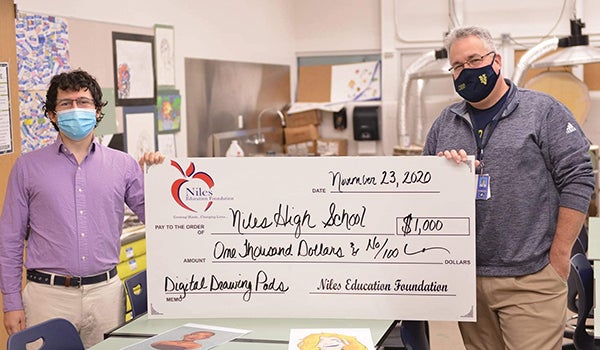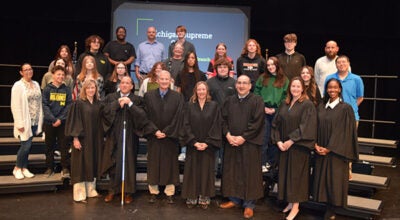Niles fine arts teacher awarded grant
Published 9:45 am Friday, November 27, 2020
|
Getting your Trinity Audio player ready...
|
NILES—On Monday, Niles High School Assistant Principal Chris Porter and Fine Arts Teacher Peter Helm received a $1,000 grant from the Niles Education Foundation.
Helm, who wrote the grant before the COVID-19 pandemic, is excited to bring in digital drawing tablets to his classroom. The timing just happened to be when students and educators are adapting learning environments from in-person to virtual — to potentially back again — this year.
“Its timing is impeccable, but that was not the intention,” Helm said. “I’ve been a strong advocate for technological art for a while.”
Helm explained materials for art classes can add up in cost, in a similar way that chemistry supplies can add up quickly. Each material is typically a single use or gets used up rather quickly, like paints.
“Once you use it, it’s gone,” he said.
With a drawing tablet, there are programs the tablet may use to emulate different techniques and materials, such as paints, colored pencils, charcoal and more. This allows users a larger space to create in, without the worry of using excess materials, until they are ready.
“On the front end, it costs more, but on the back end, it’s extremely cost-effective,” Helm said.
Helm sees the access to technological art as a big step for students as well.
“I have several kids who do have tablets already, and that’s wonderful for them,” he said. “But there’s many who have the ability to use it, but don’t have it. Kids who otherwise would not have any access to it at all. If [the student] has a serious interest in it, then they can pursue the artform once they’re in college.”
The drawing tablets also give students the ability to experiment and build confidence in a creative medium. The fear of wasting materials or continually being frustrated with a medium can be alleviated by using the digital medium first to practice.
“We don’t have a lot of paint, and you might not have a good experience with it,” Helm said. “Digital is cool because you can practice these things on the tablet, and then apply them in real life once you feel more confident. There’s no punishment in digital art. That’s really beneficial.”
Helm uses his own drawing table in class with his students. He uses it to provide feedback on artwork as well, to give notes on a digital layer.
“I can actually mark it up with suggestions, so they can keep going even though I’m not there,” Helm said.
Still, the drawing tablets will provide another way for students to practice techniques and to pursue art more seriously, if they choose. The access to the technology changes the trajectory, according to Helm.
“[They are] able to explore stuff that they otherwise would not have,” Helm said. “The way I view it is the whole purpose of school is that I take a kid to where they’re going to go. The drawing tablets are a catalyst for that. It’s not what I couldn’t get them there without them, but it exponentially expedites the whole process and makes it easier for kids to get from one place to another.”







